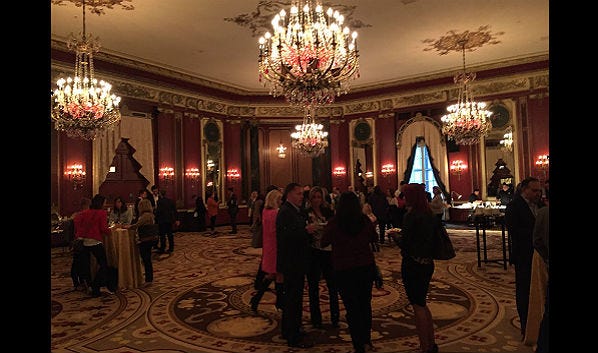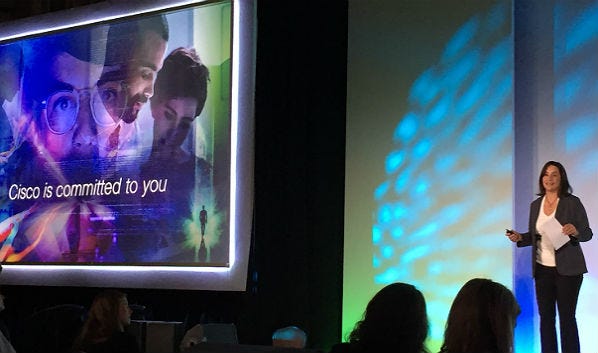Image Gallery: Cisco Marketing VelocityImage Gallery: Cisco Marketing Velocity
In the closing session of Cisco’s Marketing Velocity event, the company reflected on 10 years of change, made some announcements around Partner Marketing Central and looked ahead at the future of marketing as a discipline as digital, social and branding collide.
April 27, 2017

Already have an account?
Image Gallery: Cisco Marketing Velocity
By Lorna Garey
“Thirty percent of your shareholder value is your brand,” said Karen Walker, Cisco’s SVP and CMO. ”If you didn’t believe that, look at United.”
In Thursday’s closing session of Cisco’s invitation-only Marketing Velocity event, Walker and emcee Michelle Chiantera, Cisco’s VP, Global Partner Marketing,
reflected on 10 years of change, made some announcements around Partner Marketing Central and looked ahead at the future of marketing as a discipline as digital, social and branding collide. Get a recap of previous sessions here, and listen in on our one on on with Wendy Bahr, SVP, Cisco Global Partner Organization.“How are we going to differentiate ourselves, how are you going to deliver the most compelling experience to your customer?” Walker asked. “Customer experience will be the brand differentiator, more than price.”
She reiterated the need to closely align sales and marketing and said Cisco has made some internal changes:
Moving the company’s web presence from a publishing platform and toward an engagement engine. “I measure my team on engagement, not click through,” she said.
Providing sales teams with greater insights to accrete the sales process.
A focus on continual engagement. “Cisco loves events,” said Walker. “We love launches, too.” But she, and partners, must move away from “interrupt-driven marketing.”
A global focus, including launching a campaign in New Zealand and “following the sun.” Attendees at the event included EMEA and Australian partners.
Fewer thought-leadership campaigns, more around “stuff we have to sell.”
Emphasis on telling end customer stories. Walker cited Mercy Virtual, a health-care provider that added a telemedicine practice. The story is optimistic — building on the idea of appealing to customer emotions.
Maybe the most dramatic shift? Allowing end customers to post reviews of Cisco products and services.
Walker encouraged attendees to access online learning resources and announced new live regional conferences and additional Partner Marketing Central enablement assets.
Chad Reese, director, Partner Digital Marketing, walked through a live demo of some new PMC features, including personalization and desired business outcomes for each partner, with recommendations; unfinished assets and copy building blocks so partners can customize campaigns; a firewalled – from both other partners and Cisco – contacts database; a consolidated funding view of all the programs a partner is participating in, along with an easy way to invest those dollars in digital demand generation; direct links to Sales Connect; and a global network of digital agencies to add predictive analytics and social listening services.
“Customers need an omnichannel experience,” said Reese. “These services are intended to be used together.”
Walker points out that her team was on the main stage at the last Live event — a first, and illustrative of the rising importance of marketing.
“Digital marketing is the great equalizer,” she said. “Marketing will be the last to be industrialized, but it was the first to be digitized.”
Challenges, Changes
Cisco partners drove $4.4 billion in sales-qualified leads last fiscal year, but only 11 percent of that business came from digital. Walker challenged attendees to increase that number to 50 percent.
She closed with three challenges she sees on the horizon:
Understanding where digital ends and the human experience starts: “It’s always going to be about the human connection.”
Finding smart ways to beat the skills shortage, as Apple did by using customer photos in its ads.
Navigating the intersection of technology and marketing. “What if we had the transparency of Zillow?” she asked. Or, could AR and VR replace live events?
“I think this is the best possible time to be in marketing,” she said. “It’s both terrifying and exhilarating.”
Click through our image gallery for more highlights.
Follow editor in chief @LornaGarey on Twitter.
Cisco Marketing Velocity Tip 1: Add Plenty of Doors To Your Website

Add a “schedule a call” button to your site. People who request callbacks are higher-quality leads and deliver more conversions than click-to-chat users, says Pam Didner, content marketing expert, author, speaker, and adjunct professor. However, says Didner, don’t add contact channels at the cost of load time. She suggests running your site through Google’s free Pagespeed Insights tool; it will tell you the load time on both mobile devices and desktops and offer advice for improvement.
Didner also recommends Uberconference for a lightweight and free conference service.
Cisco Marketing Velocity Tip 2: Tightly Align Marketing and Sales

Michelle Chiantera, VP of global partner marketing, hosted a roundtable with partners Mary Beth Profrock, VP of marketing for Logicalis; Andy Lausch, CDW’s senior director, analytics and insights; and Mindsight’s Starza Thompson, marketing director, and Justine Kope, digital marketing manager.
The backdrop was an audience survey that showed about half of attendees consider these groups either only somewhat or not at all aligned.
While Lausch says CDW doesn’t link the compensation for sales and marketing teams, “I wish I could.” At minimum, the partners say, put KPIs in place and ensure everyone is pulling in the same direction. Link leads to revenue to ROI to demonstrate the value of marketing to the bottom line. Sounds obvious, but some attendees we spoke with say that’s not yet the case in many shops. The last thing marketing experts want is to be considered a cost center — so use data to your advantage.
Cisco Marketing Velocity Tip 3: Marketing Tools Needn’t Be Expensive

While Cisco hosted its welcome reception in the sparkling Red Lacquer Room, Mindsight’s Thompson says her company depends on free and inexpensive tools. These include Hubspot, SEMRush Alexa, Yoast and YouTube Director for video, which was a hot topic. Experts say video needn’t be studio quality. It’s more important to have a presence on YouTube.
Lausch weighed in that low-cost tools have another payoff: agility. When a partner doesn’t have a big sunk investment in high-end marketing software suites, they can experiment to see what works for them.
Another tool that had a lot of buzz among attendees is Pardot, a Salesforce add-on that many say beats Marketo, especially with the just-released Engagement Studio.
Mindsight recently rebranded from Tympani to better represent managed-service practice growth. Thompson says the previous name was difficult to pronounce and wasn’t reflective of the company’s current services, but that a major brand change isn’t to be undertaken lightly.
Cisco Marketing Velocity Tip 4: It’s Not B2B or B2C. It’s H2H – Human To Human.

The United fiasco was an object lesson for several speakers. Brand futurist and best-selling author Martin Lindstrom emphasized the need to appeal to human emotions, asking, “Are you using small data to look for the needs of your end customers?” That “small data” can be mined from social selling; few people today keep walls between their personal and business personas, so marketing pros can collect clues on how to create stickiness from sites including LinkedIn and Facebook.
Lindstrom cited examples of companies that appealed to customers’ empathy to increase their businesses. Maersk, for example, sometimes was late with deliveries because of arctic weather. When the marketing team tweeted images of ships encased in ice, not only did customers forgive, the company added 149 million-dollar deals.
More free tools from Lindstrom: Facebook Spaces, NinjaOutreach.com, Wordstream.com/keywords.
Cisco Marketing Velocity Tip 5: Stop Trying to Scare Customers Into Buying.

Following on the H2H concept, marketers need to quit trying to sell using FUD — enough with the “hacker in a hoodie” images, says Gene Hall, senior director of security sales. Customers want to answer one basic question: Are we secure? The bad news, of course, is that they will never be 100 percent attack-proof. But they can shrink the time between attack and detection. “This is the key thing that matters,” says Hall.
“The low-hanging fruit is greater than $20 billion right now,” said Hall, referring to customers with unprotected endpoints, no cloud access control and other weaknesses. “This is a very significant opportunity. But it’s highly contested.”
Help your sales team go in with a positive vision and an empowering security message, and they’ll win.
Cisco Marketing Velocity Tip 6: Get Them Hooked Early

“If you don’t get a customer to see value in the first 90 days, you’re unlikely to see a renewal,” says Steve Cox, senior director, digital experience and analytics. He says marketers need to be vigilant for warning signs. “Say a feature should be used every week, but it’s been 90 days,” says Cox. “That should raise alert flags.”
He used the example of Uber, which found that only 10 percent of those who downloaded the app used it. To combat that, the company reached out with personalized messaging, instructions and promo codes. The same concept applies to a UCaaS system or any SaaS sale. The infinity symbol Cisco uses to illustrate this concept is no accident, and it’s something partners transitioning to MRR need to embrace.
“Go crazy to make customers immediately start using and keep on using,” he said.
Cisco Marketing Velocity Tip 7: Automate Renewals and Expansions, Starting Early

Cox also touched on the actions that go into renewals and expansions of licensed products. Customers now go through most of the sales cycle – 57 percent – before ever talking to a human. By 2020, that will be 80 percent, per both Gartner and Forrester. The problem is, remove personalized experiences and you remove the incentive to actively renew, much less buy more. His recommendation is to automate the process, but with a focus on personalization and omnichannel contacts. At T-120 days, start email notifications and go from there. Today, it usually takes a lot before a customer sees the line from trusted adviser to stalker get crossed: Ninety-eight percent say they’re happy to get email notifications, but it is important who sends them.
Marketers need to own this process — suggest value-adds to entice existing customers to buy more, build a flow chart of conditional touches, and track the customer journey.
Cisco Marketing Velocity: Exit Advice

Be curious and listen.
After a presentation by AOL digital prophet David Shing, Michelle Chiantera, VP, Global Partner Marketing, closed with some parting advice: “We have to iterate, we have to learn, we have to fail,” she said. “Second, be curious.”
“Third, listen,” she said. “Listen and learn.”
Finally, Chiantera announced that the 2018 Marketing Velocity event will be in Barcelona.
Cisco Marketing Velocity: House of Blues

Live events bring the personal touch in an analog world.
Events may be analog, but they’re great for bonding, as Velocity’s closing party shows. Cisco executives mingled with partners while enjoying music and a shrimp po’ boy bar. One attendee said her company does several dozen customer gatherings throughout the year and sees positive ROI.
Image Gallery: Cisco Marketing Velocity
Please click here for more Channel Partners galleries.
Read more about:
AgentsAbout the Author
You May Also Like


